Do current programmes lead to equity for ākonga Māori and Pacific students?
A Māori or Pacific student is awarded University Entrance at half the rate of other students.
This inequity has remained unchanged for over ten years, limiting the range of opportunities available to Māori and Pacific students immediately after finishing school, and potentially having long-term impacts on further study pathways and career choices. Data indicates that the assessment programme mix of unit and achievement standards contributes to this inequity.
University Entrance (UE) is the minimum requirement to proceed directly from a New Zealand secondary school to a New Zealand university.
To be awarded UE, a student needs to attain NCEA Level 3, with a minimum of 14 credits at Level 3 in each of 3 UE-approved subjects. The student must also have met thresholds for literacy. These requirements are designed to make sure students are ready to undertake university study.
Find out more about the requirements for University Entrance
To address the inequity, we need to understand the current pathways students are on, and whether they create situations which make it more difficult for Māori and Pacific students to be awarded UE.
Download this paper as a PDF
On this page
Introduction
Between 2011 and 2019, attainment of NCEA Level 3 by each successive Year 13 cohort has been increasing (by 29% overall). Over the same period, attainment of UE has also increased, but much less (by 7%).
The large gap in University Entrance (UE) attainment between Year 13 Māori and Pacific students on the one hand, and Year 13 Asian and European students on the other, persists.
This paper investigates whether there is evidence of systemic differences in the NCEA assessment programmes of Māori and Pacific Year 13 NCEA Level 3 achievers which mean they are not positioned to achieve the University Entrance award in the same proportion as European and Asian students. It also investigates the nature of their assessment programmes prior to Year 13.
The analysis uses NCEA data (assessment standard entries and results) that NZQA holds for the cohort of 2019 Year 13 NCEA Level 3 achievers.
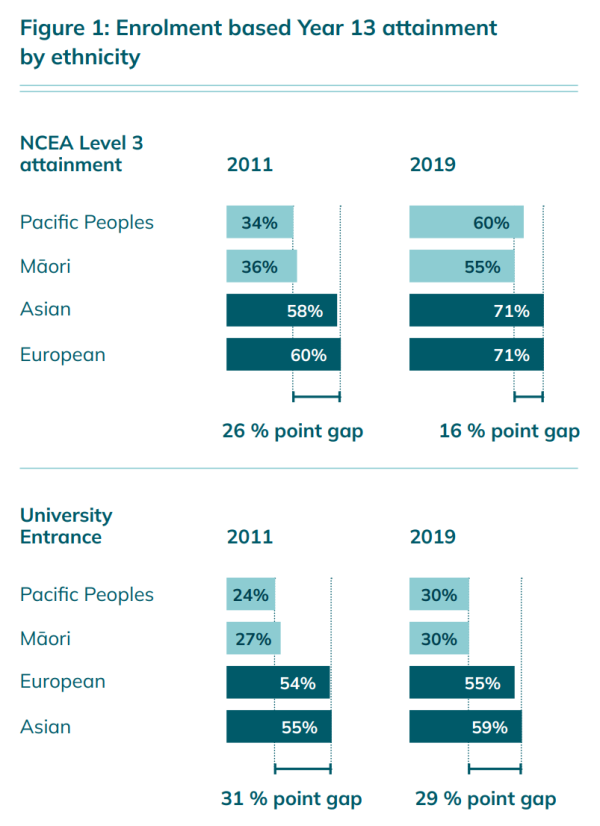
Why is the UE award important?
The UE award provides students with the immediate opportunity to take on university education when leaving school, with the significant benefits that this brings to them and their whānau, and to New Zealand as a whole.
It is an award additional to NCEA Level 3 and is considered by many schools to be the leaving qualification to aspire to.
While not all students will share identical academic aspirations, similar attainment of UE across ethnicities is an integral part of achieving overall education equity.
The UE award is intended to provide evidence that a student has a reasonable chance of success at degree level study in a New Zealand university.
This evidence is considered met through the achievement of NCEA Level 3, the 42 credit three-subject requirement (an indicator of breadth and depth of learning at NCEA Level 3) and the UE literacy requirement (5 credits in reading and 5 credits in writing at NCEA Level 2 or above).
In 2019:
- 50% of Year 13 Pacific NCEA Level 3 achievers did not achieve UE
- 22% of Year 13 European NCEA Level 3 achievers did not achieve UE
- 46% of Year 13 Māori NCEA Level 3 achievers did not achieve UE
- 17% of Year 13 Asian NCEA Level 3 achievers did not achieve UE.
Barriers to UE achievement
Which of the UE requirements are not being met by students who achieve NCEA L3 but do not achieve the UE award?
In 2019, 8,333 students achieved NCEA Level 3 and not UE. The most common reason for not achieving UE was that the three-subject requirement was not met (4,955 of the 8,333 students, 60%).
A further 3,206 students (39%) did not meet both the three-subject and the UE literacy requirement. Māori and Pacific students were more likely to not meet both, than European students.
Figure 2 illustrates the ethnicity pattern. This data shows that attaining UE literacy is still a significant barrier for many students.
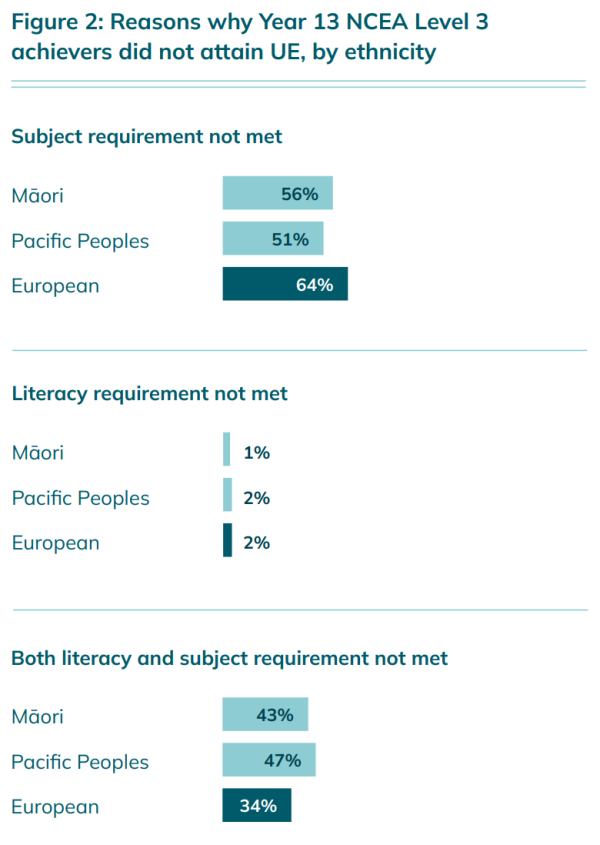
A closer look at the assessment standard entries of those students who did not meet the three-subject requirement shows two distinct groups of students: those who were entered for sufficient credits to meet the requirement and those who were not.
Figure 3 below shows that Māori Year 13 NCEA Level 3 achievers were much less likely than their Pacific, European or Asian peers to be entered in sufficient credits to meet the three-subject requirement.
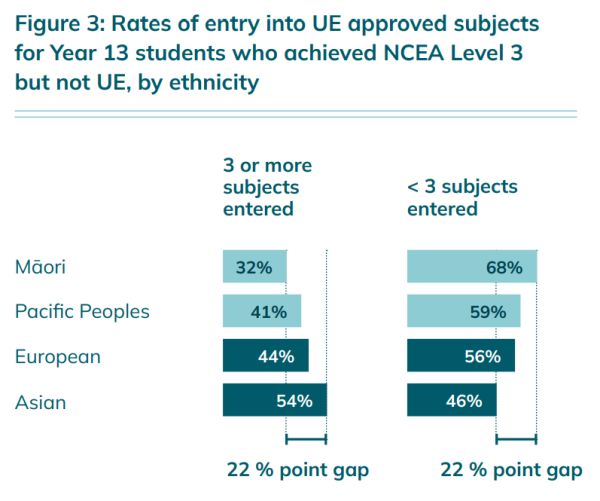
Programme design: if not UE, then what?
There are two types of standards assessed in New Zealand secondary schools: achievement standards and unit standards. While unit standards count towards an NCEA qualification, they do not contribute to the 3 subject requirement for UE.
On average, 46% of all credits assessed for Year 13 students who achieve NCEA Level 3 but not UE are comprised of unit standards at Level 3 and above. In contrast, unit standards at Level 3 and above make up only 7% of credits assessed for those Year 13 students who achieve UE. Figure 4 below illustrates this.
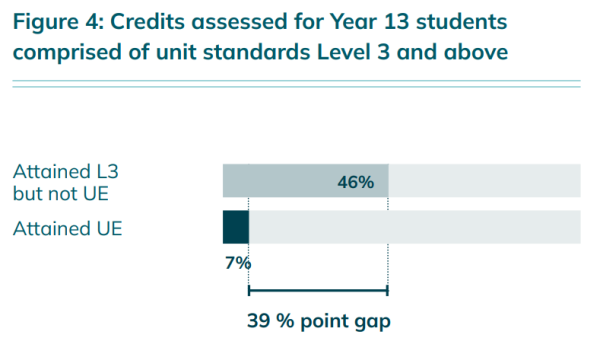
This pattern is slightly exacerbated for Māori and Pacific students, with the assessment programmes of Year 13 Māori and Pacific students who achieve NCEA Level 3 but not UE including higher proportions of unit standards than their European and Asian peers. Figure 5 below illustrates this.
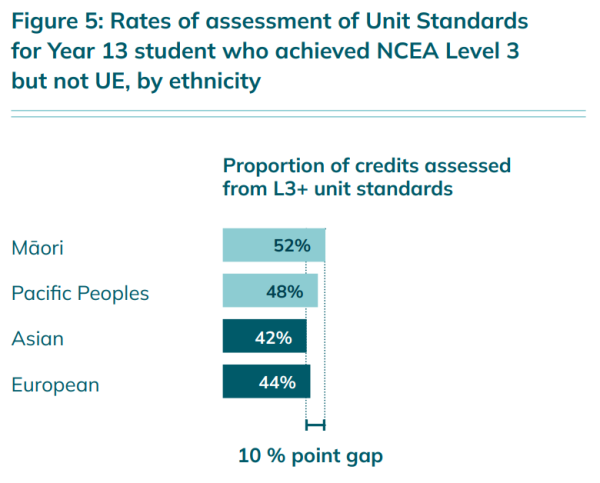
Year 11 and 12 assessment programmes of NCEA Level 3 achievers
The analysis above shows that there are differences in both the structure and content of the assessment programmes of those who both attain NCEA Level 3 and are awarded University Entrance, and those who do not.
Extending the analysis to look at the Year 11 and 12 assessment programmes of NCEA Level 3 achievers provides further insight into what constitutes a pathway that is more likely to lead to success in both NCEA Level 3 and UE.
We looked at the number of courses of 14 or more (14+) credits these students were assessed in Years 11 and 12. We found that successful students were more likely to have done 5 or more (5+) courses in Year 11, and much more likely to have done 5 or more courses in Year 12, than students who achieved NCEA Level 3 but not UE. Figure 6 below illustrates this.
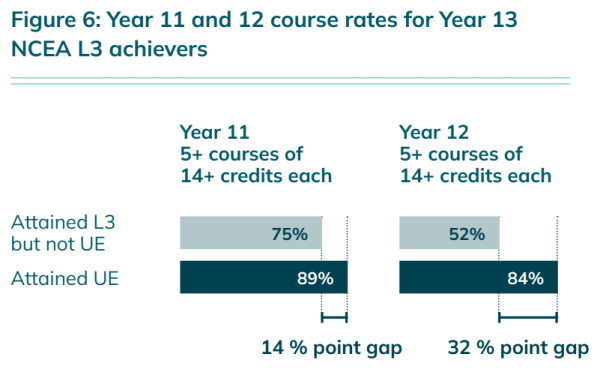
By ethnicity, the same pattern is evident for Māori and Pacific students who attain UE, although the proportions achieving 5 or more courses in Years 11 and 12 are lower than for European students. Figure 7 below illustrates this.
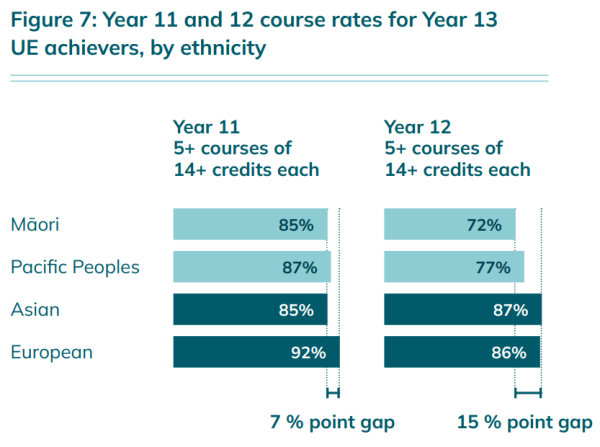
Schools with higher UE attainment for their Māori and Pacific students
We identified 32 schools where UE attainment of their Māori and Pacific students is at least 10 per cent higher than their decile band average. We have only looked at schools with more than 100 Year 13 students, and where at least 20% of their students are Māori and/or Pacific.
By school type, 75% are state schools and 25% state integrated.
A next step could be to work with these schools to identify any specific strategies that may be underpinning these higher achievement rates for their Māori and Pacific students. Findings could be shared with other schools to help them make positive changes.
Conclusion
NZQA acknowledges that UE attainment may not be a pathway that all NCEA Level 3 achievers and their whānau aspire to. However, similar rates of awarding UE across ethnicities is an integral part of achieving education equity. An analysis of the data shows that the system is not serving Māori and Pacific students to achieve UE.
The most common reason NCEA Level 3 achievers are not awarded UE is that the three-subject requirement is not met (60%). A significant proportion of these students do not meet the Level 2 UE Literacy requirement either (a further 39%).
There is evidence that Year 13 assessment programmes – for Māori students in particular – do not position them well to be awarded UE. More than two-thirds (68%) of Māori NCEA Level 3 achievers are not entered for enough credits in UE-approved subjects to achieve the UE requirement.
Those Year 13 students who achieve NCEA Level 3 but not UE typically have assessment programmes that include more unit standards.
A key indicator of success in attaining UE in Year 13 is assessment in five or more courses of 14+ credits each in Years 11 and 12. Year 13 students who achieved NCEA Level 3 but not UE were assessed, on average, in fewer Year 11 and Year 12 courses offering 14 or more credits than those who achieved UE.
A small number of schools (32) have been identified where the UE attainment of their Māori and Pacific students is 10 or more per cent higher than their decile band average, as a starting point for further enquiry about their learning and assessment programmes and student support.
Recommendations and suggestions for further analysis
To improve University Entrance attainment, we recommend schools and Government agencies (including NZQA) pay attention to the following key areas:
- Conduct ongoing measurement and reporting of participation in programmes of learning and assessment, broken down by ethnicity.
- Encourage students to consider the breadth and depth of assessment programmes in Years 11 and 12 (5 or more courses of 14+ credits each) with a focus on achievement standard attainment.
- Support students who may want to consider university study after leaving school to undertake a well-structured NCEA L3 assessment programme with sufficient achievement standards to meet the three-subject UE requirement.
- Be mindful of UE Literacy requirements, including supporting a Year 12 learning programme that supports opportunities to achieve the required UE literacy credits.
- Encourage teachers and whānau to consider close tracking of each student’s entries and achievement data in Years 11, 12 and 13.
- Consider the role streaming may be playing in the programmes of study available to students.
Further research and analysis could include a more in-depth look at the Year 11 and 12 assessment programmes for those Year 13 students who attain UE, in particular at the 32 schools where UE attainment for Māori and Pacific learners is 10% higher than their decile band average.
References
Tokona Te Raki – Māori Futures Collective (2019). Education Awa. Education outcomes for Māori.
Ministry of Education. (2021). He Whakaaro: What are 15-year-olds’ qualification expectations and are we helping to fulfil them?. Available at:
www.educationcounts.govt.nz/publications/series/he-whakaaro (external link)
NZQA. (2020). 2019 Annual Report on NCEA, University Entrance and NZ Scholarship Data and Statistics.
Webber, M., Eaton, J., Cockle, V., Linley-Richardson, T., Rangi, M., O’Connor, K. (2018). Starpath Phase Three – Final Report. Auckland: Starpath Project, The University of Auckland. Available at:

